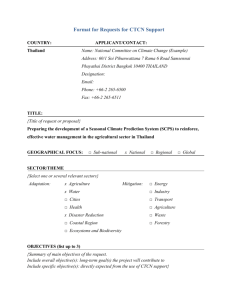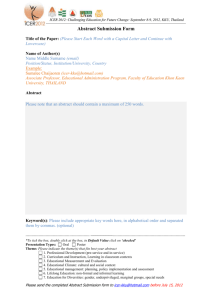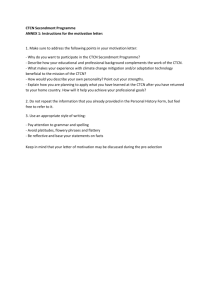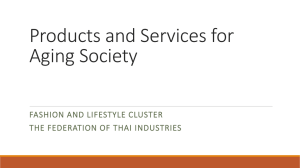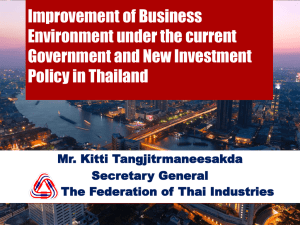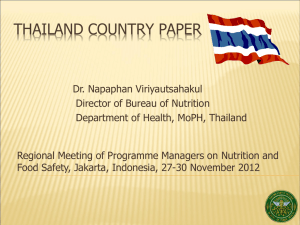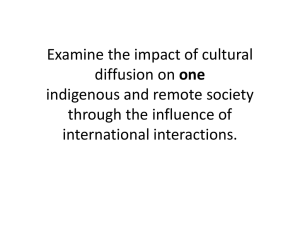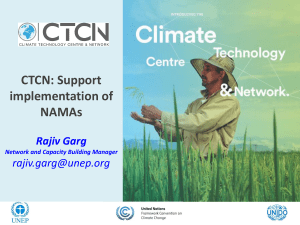19 Downgraded sample request - AIT adaptation
advertisement
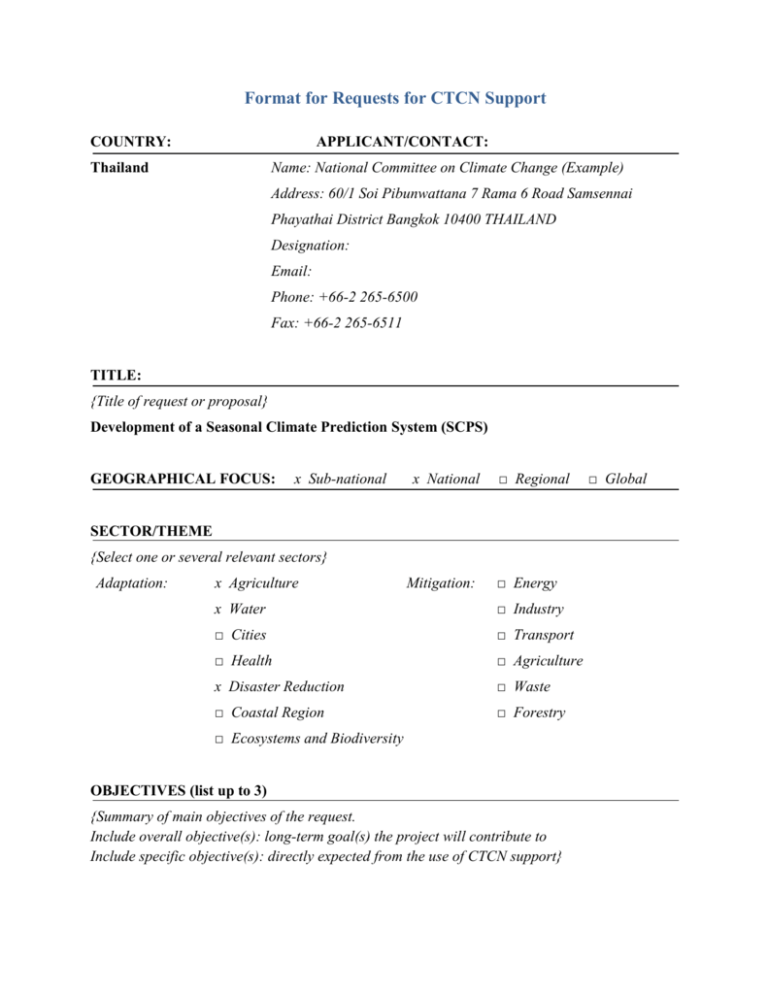
Format for Requests for CTCN Support
COUNTRY:
APPLICANT/CONTACT:
Thailand
Name: National Committee on Climate Change (Example)
Address: 60/1 Soi Pibunwattana 7 Rama 6 Road Samsennai
Phayathai District Bangkok 10400 THAILAND
Designation:
Email:
Phone: +66-2 265-6500
Fax: +66-2 265-6511
TITLE:
{Title of request or proposal}
Development of a Seasonal Climate Prediction System (SCPS)
GEOGRAPHICAL FOCUS:
x Sub-national
x National
□ Regional
SECTOR/THEME
{Select one or several relevant sectors}
Adaptation:
x Agriculture
Mitigation:
□ Energy
x Water
□ Industry
□ Cities
□ Transport
□ Health
□ Agriculture
x Disaster Reduction
□ Waste
□ Coastal Region
□ Forestry
□ Ecosystems and Biodiversity
OBJECTIVES (list up to 3)
{Summary of main objectives of the request.
Include overall objective(s): long-term goal(s) the project will contribute to
Include specific objective(s): directly expected from the use of CTCN support}
□ Global
To perform a feasibility study to select the appropriate instruments, and scope, for the
Seasonal Climate Prediction System.
To develop a multi model ensemble to make forecasts for major climatic and hydrological
variables at different temporal and spatial scales.
To carry out climate change impact assessments for irrigation water availability in major
river basins in Thailand using the SPCS, and develop adaptation strategies in response to
anticipated change.
To reduce the country’s vulnerability to climate change
BACKGROUND INFORMATION AND CONTEXT (up to 1 page)
{Background information on the existing conditions surrounding the request
Main problems and difficulties the request aims to address
Brief description of any previous or ongoing related work being undertaken (nationally or
regionally) and any bottlenecks or success stories encountered
If necessary, attach relevant documents}
Climate change is one of the most pressing issues of our time. Adaptation to the adverse
effects of climate change is vital in order to reduce the impacts of climate change that are
happening now and increase resilience to future impacts.
Thailandis a country located at the centre of the Indochina peninsula in Southeast Asia. It
is bordered to the north by Burma and Laos, to the east by Laos and Cambodia, to the
south by the Gulf of Thailand and Malaysia, and to the west by the Andaman Sea and the
southern extremity of Burma. Its maritime boundaries include Vietnam in the Gulf of
Thailand to the southeast, and Indonesia and India in the Andaman Sea to the southwest.
Thailand exports an increasing value of over $105 billion worth of goods and services
annually. Major exports include Thai rice, textiles and footwear, fishery products, rubber,
jewellery, cars, computers and electrical appliances. Thailand is the world's no.1 exporter
of rice, exporting more than 6.5 million tons of milled rice annually. Rice is the most
important crop in the country. Thailand has the highest percentage of arable land, 27.25%,
of any nation in the Greater Mekong Subregion. About 55% of the arable land area is used
for rice production.
A growing body of empirical evidence suggests that the water sector in Thailand is likely
to be significantly impacted by climate change. The areas of concern include: reliability of
water supply, the risk of flooding and droughts, impacts on health, agriculture, energy and
aquatic ecosystems. Even in the present times water management cannot satisfactorily
cope with current climate variations, leading to large damages because of floods and
droughts (e.g. the unprecedented flood event in 2011), and this will in all probability have
a multiplier effect under changing climate regimes. The country, which is one of the
world's major food exporters, continues to rely heavily on rainfall, a major factor in the
planning and management of irrigation projects and crop yields. The agricultural sector
takes up 70% of the nation’s total water supply. Hence, any change in rainfall, especially
in terms of overall precipitation levels and distribution patterns, carries huge consequences
for the agricultural sectorThe proposed SCPS is expected to take into account the climate
variability in developing predictions, and will serve as a powerful tool in developing
adaptation strategies in response to climate change. Although Thailand has a prediction
system in place, operated by the Thai Meteorological Department, there is a need for stateof-the-art technologies and sophisticated modeling tools to provide more reliable and
efficient outputs.
ALIGNMENT WITH NATIONAL DEVELOPMENT PRIORITIES (up to half a page)
{Justification of how the request is in line with national plan and priorities
{Please reference existing national documents (i.e. national development plan, poverty reduction
strategy, climate change priorities, technology plans and strategies, etc.)}
In recent years, Thailand has begun to mainstream ‘climate change’ into all its major
policies (e.g. National Water Policy Framework 2008; National Strategy on Climate
Change Management 2008-2012; National Master Plan on Climate Change 2010 -2019
etc.), and the water sector is an integral component of each of these policies. Further, the
government has also established new institutes (e.g. National Committee on Climate
Change; Thailand Greenhouse Gases Management Organization etc.) to cooperatively
work within the national frameworks. Having an efficient SCPS will, thus, ease the
translation of policy into practice.
REQUEST PROCESS AND SELECTION (up to half a page)
{Explain how the request was selected (organization(s) that initiated the process, stakeholders
involved, consultations or meetings conducted, etc.)}
The request has been selected based on the need to adapt the country to climate change
This request has been developed through a participative process where first the need was
ascertained through a series of interactive meetings with relevant stakeholders (e.g. a
Technological Needs Assessment carried out recently in collaboration with UNEP
(2012)), and then determining the scope and extent of the service required from the
CTCN.
STAKEHOLDERS
{Please list which institutions, organizations, and private sector actors would be key in carrying
out the activities requested and indicate their role in the project implementation.
List direct and final beneficiaries of these activities}
Name
Role
Thai Meteorological
Department
Department of Disaster
Prevention and Mitigation
National Science Technology
and Innovation Policy Office
Provides information on
weather forecasts
Prepares plans and strategies
on mitigation and adapation
Facilitating the science-policy
interface for continuous
upgrading of the SCPS
Database management
Carrying out climate change
Impact assessments;
Developing adaptation
strategies
Department of Water Resources
Royal Irrigation Department,
Department of Groundwater
Resources, Department of
Agriculture, Others
Category
(Beneficiary or Partner)
Partner and Beneficiary
Partner and Beneficiary
Partner
Partner and Beneficiary
Partner and Beneficiaries
TYPE OF REQUEST AND EXPECTED ACTIVITIES (up to 1 page)
{List the various activities to be conducted in order to meet the request
Indicate the main deliverable(s) to be developed}
This request requires CTCN assistance for the following components:
-
Feasibility assessments
-
Methodology development
-
Capacity building
In this context, the CTCN assistance is required to undertake the following activities:
1. To perform a feasibility study to select the appropriate instruments, and scope, for the
SCPS: The SCPS, in this context, accounts for both meteorological and hydrological
variables. Further, the outputs of the SCPS are to be applied for effective management of
water in the agricultural sector. Hence, the system will be expected to address a range of
functions, which may include (but not limited to):
Seasonal weather variability
Climate changes patterns
Short and long range forecasting
Hydrological modeling
Irrigation and crop modeling
2. To develop a methodological framework for modeling to make the seasonal
predictions, based on the outcomes of the feasibility study. It is expected that the
framework will:
(i) Outline a clear approach for collecting the data, and its subsequent handling, for the various
predictions, at different scales (both temporal and spatial)
(ii) Provide definitive technical guidelines on the use of modeling instruments
(iii) Establish a mechanism for continuous monitoring and storage of the information
(iv) Make provisions for reporting the relevant information to all stakeholders and the general
public through online portals and websites
(v) Outline a strategy for dynamic improvement of the system to take into account more
pertinent issues as they arise.
3. To build capacities of staff from the agency managing the SCPS and other concerned
agencies, in the use and application of modern forecasting and modeling techniques,
preparing them for the development of the multi-model ensemble for prediction activities.
The training will be provided for the technical and managerial issues established in the
feasibility study and the methodological framework.
It is desired that this capacity building exercise will upgrade the participants’ knowledge, both
theoretical and practical, regarding the implications of climate change and its potential impacts
on water resources and agriculture. Further, it will equip them with fluency in using state-of-theart technological tools and methods required to develop, monitor and sustain the SCPS.
(a)
To carry out climate change impact assessments for irrigation water availability in
major river basins in Thailand, and develop adaptation strategies in response to
anticipated change:
To carry out climate change impact assessments at longer temporal scales, expertise in
the use of Global Climate Models (GCMs), and associated techniques like downscaling
and bias correction, and irrigation (crop water) modeling is paramount. It is desired that
the CTCN support, through the capacity building activities, concerned personnel will
develop good confidence in using the GCMs, and apply the information obtained from it
in developing models to assess, and deal with, the impacts on climate change on
irrigation water availability in the major river basins of Thailand. As part of this subcomponent, CTCN is requested to help in the identification and procurement of
appropriate irrigation (crop water) modeling tools.
EXPECTED TIME FRAME
{Approximate duration of the expected activities}
It is envisaged that the SCPS will be in place by the end of 2015, while the assessment of climate
change impacts on water availability for irrigation will be completed by the end of 2016.
MONITORING AND EVALUATION (up to half a page)
{What processes can be put in place to monitor and evaluate the implementation and results of
the project}
It is desired to have an online database for the information gathered, which can be networked to a
national water information center at a later stage. There will be a specific budget earmarked for
the operation and maintenance of the system. To ensure the sustainability of the system, there
will be a need to establish an operative model which will clearly outline the scope and
responsibility of each stakeholder. The model will also make provisions for information
exchange with other international organizations, and timely capacity building exercises for
concerned personnel.
EXPECTED RESULTS AND IMPACTS (up to half a page)
{List the direct results of the activities, and the expected economic, social and environmental
impacts of the activities of the medium and long-term.
What follow-up steps would be required to ensure the sustainability of the activities in the
medium to long term and scale-up over time}
This request is made for a national team consisting of delegates from the relevant government
agencies of Thailand (e.g. Thai Meteorological Department; Royal Irrigation Department;
Department of Water Resources; Department of Groundwater Resources; Department of marine
and coastal resources; Office of Natural Resources and Environment Policy and Planning etc.).
The total strength is expected to be around 50.
It is hoped that there will be a reduction in problems commonly associated with climate change
in the region, like floods and droughts, in order to reduce vulnerability of agricultural production
and farmers, as well as ensuring food security.
DATE AND SIGNATURE
NDE name:
Signature:
Institution:
Date:
**PLEASE ATTACH ANY RELEVANT BACKGROUND DOCUMENTS
